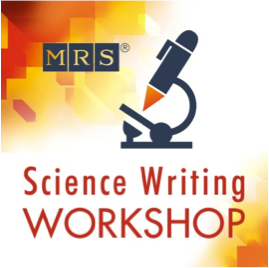DESCRIPTION
This workshop on scientific journalism and interviewing skills was prepared and given by a team of scientists, educators and editorial staff at the Materials Research Society. The workshop is designed as a full-day, with a post-workshop assignment and individual follow-up by the instructional staff. The instructional design is modifiable so that this can be taught as two independent half-day workshops. Ideal participant size is 15. The program is designed for researchers, scientists, science educators and students who are interested in journalism and science writing and focuses on writing science stories that engage both the general public and other scientists. Participants learn about various forms of science writing, helpful resources and potential career opportunities. Quotes from Workshop Participants: "The contents shown here are not only useful in journalistic scientific writing, but also technical science writing and I’m sure it will have an impact on how I’ll network." (Fall 2013 workshop, Boston, MA) "It was really great, I’ve learned so much and rediscovered my joy while writing and how rewarding this work can be." (Spring 2014 workshop, San Francisco, CA)
DESCRIPTION
This workshop on scientific journalism and interviewing skills was prepared and given by a team of scientists, educators and editorial staff at the Materials Research Society. The workshop is designed as a full-day, with a post-workshop assignment and individual follow-up by the instructional staff. The instructional design is modifiable so that this can be taught as two independent half-day workshops. Ideal participant size is 15. The program is designed for researchers, scientists, science educators and students who are interested in journalism and science writing and focuses on writing science stories that engage both the general public and other scientists. Participants learn about various forms of science writing, helpful resources and potential career opportunities. Quotes from Workshop Participants: "The contents shown here are not only useful in journalistic scientific writing, but also technical science writing and I’m sure it will have an impact on how I’ll network." (Fall 2013 workshop, Boston, MA) "It was really great, I’ve learned so much and rediscovered my joy while writing and how rewarding this work can be." (Spring 2014 workshop, San Francisco, CA)
OBJECTIVES
BIG IDEA
A science journalist can facilitate communication between scientists and non-scientists by writing engaging stories that draw the reader into the content.
LEARNING GOALS
Gain greater appreciation for the importance of communication skills in science and engineering careers
Gain greater appreciation for enhancing science literacy through written media
Become involved in science communication and outreach through one or more forms of media
NANO CONTENT MAP
Scientists and engineers have formed the interdisciplinary field of nanotechnology by investigating properties and manipulating matter at the nanoscale.
DOWNLOAD FILES
- Science Writing Workshop Lesson Plan (PDF)
- Science Writing Workshop - Facilitators & Instructors (PDF)
- Science Writing Workshop Materials List (PDF)
- How to Conduct an Interview - Instructional Slides (PPTX)
- How to conduct an interview - Talking Points (PDF)
- Opportunities for Science Writing slides (PPTX)
- Opportunities for Science Writing Talking Points (PDF)
- Science Writing Workshop Application Form (DOC)
- Science Writing Workshop Evaluation Form (DOC)
- Post-Workshop Assignment (DOC)
- Science Writing Workshop Lesson Plan (DOC)
- Science Writing Workshop Materials List (DOC)
- Opportunities for Science Writing Talking Points (DOC)
- How to conduct an interview - Talking Points (DOC)
Credits
Materials Research Society
Developed for the NISE Network with funding from the National Science Foundation under Award Number 0940143. Any opinions, findings, and conclusions or recommendations expressed in this product are those of the authors and do not necessarily reflect the views of the Foundation.
Creative Commons Attribution Non-Commercial Share Alike 3.0 United States (CC BY-NC-SA 3.0 US).
View more details

NISE Network products are developed through an iterative collaborative process that includes scientific review, peer review, and visitor evaluation in accordance with an inclusive audiences approach. Products are designed to be easily edited and adapted for different audiences under a Creative Commons Attribution Non-Commercial Share Alike license. To learn more, visit our Development Process page.

